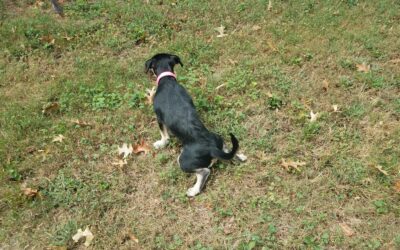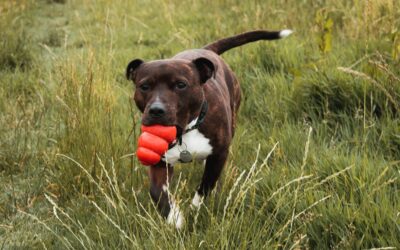1. You Should Use Food
While food can be a useful tool in various dog training scenarios, its role in alleviating separation anxiety is often misunderstood and overemphasized. Generally, I advise against using food as a primary tool for managing separation-related stress.
Research indicates that many dogs experiencing significant separation-related distress are too anxious to eat. This physiological response mirrors what often happens in humans under stress: the digestive system can effectively shut down under duress as the body prioritizes a “fight or flight” response over digestion (Brigham Young University). A dog refusing food that they would normally readily consume can be a key indicator that they are “over-threshold” – meaning their anxiety levels are too high for them to engage in normal behaviors.
Even if a dog initially seems settled while consuming a long-lasting treat like a stuffed Kong or engaging with a remote feeder, their underlying distress often returns, or even intensifies, as soon as the food is gone. The temporary distraction provided by food does not address the fundamental discomfort the dog feels when left alone. No matter how creative one gets with stuffing Kongs or using automated feeders, the food supply will inevitably run out. Therefore, it’s paramount to help dogs feel genuinely comfortable and secure when left alone, without relying on food to momentarily mask or manage their anxiety (Overall, 2013). The goal should be to build true independence and resilience, not create a dependency on a temporary food-based distraction.
2. Getting a Second Dog
The idea of getting another dog to help a current furry friend with separation anxiety is a common thought, often stemming from a natural human inclination to provide companionship. However, it’s a solution that frequently disappoints and can even exacerbate the problem.
There is currently no scientific evidence to suggest that adding a second dog will reliably alleviate separation anxiety in the original dog. In fact, anecdotal evidence and clinical experience often point to the contrary (Overall, 2013; Landsberg et al., 2017). Most dogs who struggle with being alone are anxious about being separated from their primary human companions, not necessarily other dogs. Their distress is often rooted in the absence of their key attachment figure.
Introducing a new dog can sometimes make the situation more complicated. The new dog might not provide the specific comfort the anxious dog needs, or worse, they could even pick up on the original dog’s stress and anxiety cues, potentially developing their own separation-related issues. This phenomenon, known as social learning or emotional contagion, can lead to two anxious dogs instead of one (Overall, 2013).
Instead of acquiring a second dog, focusing on strategies that directly help the current dog cope with being alone is almost always more effective. This typically involves structured training, behavior modification techniques, and sometimes pharmacological support under veterinary guidance (Overall, 2013; Sherman & Mills, 2008).
3. Using a Crate

Many people believe that crating a dog will solve separation anxiety. While a crate can be a useful management tool for house-training or preventing destructive behaviors when an owner is present or for short, calm absences, it does not address the root cause of separation anxiety.
While a crate might prevent your dog from destroying household items or soiling inside your home, it primarily functions as a containment device. It doesn’t resolve the dog’s underlying distress; instead, it simply restricts their ability to express their anxiety through destructive or inappropriate behaviors (Overall, 2013). Your dog’s fundamental feelings of fear, panic, or isolation when left alone remain unchanged, merely contained within the crate.
In some cases, a dog might appear calm or quiet in a crate when left alone. However, this can be a deceptive sign. It might indicate that the dog is “shut down” or has entered a state of learned helplessness, rather than truly being relaxed and comfortable (Reisner, 1999). Furthermore, for dogs with significant separation anxiety, being confined in a crate can intensify their panic, leading to frantic escape attempts that can result in serious self-injury, such as broken teeth, lacerations, or damaged nails, as they desperately try to get out (Overall, 2013). For dogs with separation anxiety, the crate can become a symbol of their distress rather than a safe haven.
4. That Dogs Feel Guilt or Have a Guilty Look

The widely discussed “guilty look” in dogs has been the subject of extensive scientific research, challenging the anthropomorphic interpretations often placed upon it by human owners.
A seminal study by Dr. Alexandra Horowitz, a canine cognition researcher at Barnard College, revealed compelling insights into this phenomenon. Her research, published in Behavioural Processes (Horowitz, 2009), demonstrated that dogs predominantly exhibit what owners perceive as “guilt” when their owner is scolding them, or in anticipation of scolding, regardless of whether the dog actually committed a transgression. This strongly suggests that what we interpret as “guilt” in dogs is, in fact, a display of appeasement behaviors, submission, or, most accurately, fear in response to human body language and vocalizations.
It’s crucial to clarify a common misunderstanding: Horowitz’s research did not claim dogs cannot feel guilt in a complex human sense (which is difficult to prove or disprove), but simply that her experiment did not provide evidence for it. More precisely, the study demonstrated that dogs, conditioned by past punishments or negative interactions related to specific actions (e.g., raiding the bin), react with fear and appeasement gestures when their owner returns, potentially even before any verbal reprimand or discovery of misbehavior. Owners often interpret this post-misbehavior appeasement display as their dog “knowing” they misbehaved or feeling “guilty,” but the reality is the dog is likely experiencing anxiety, fear of punishment, and attempting to defuse a potentially confrontational situation, rather than exhibiting a moral understanding of “wrongdoing” or intentional defiance. This highlights the importance of understanding canine communication from their perspective, rather than projecting human emotions onto them.
Where Can I Get Help For My Dog With Separation Anxiety?
Julie Naismith has a great book called ‘Be Right Back’ and a website which is a great resource which can be found here https://julienaismith.com/category/be-right-back/.
You can find information on my separation anxiety packages at the button below.
References
Horowitz, A. (2009). Disambiguating the “guilty look”: Salient prompts to a familiar canine expression. Behavioural Processes, 81(3), 447-454.
Landsberg, G., Hunthausen, W., & Ackerman, L. (2017). Behavior problems of the dog and cat (3rd ed.). Elsevier Saunders.
Overall, K. L. (2013). Manual of clinical behavioral medicine for dogs and cats. Mosby Elsevier.
Reisner, I. R. (1999). The physiological effects of fear and anxiety in dogs. Veterinary Clinics of North America: Small Animal Practice, 29(6), 1303-1317.
Sherman, B. L., & Mills, D. S. (2008). Canine separation anxiety: An update on pharmacologic and behavioral treatment. Veterinary Clinics of North America: Small Animal Practice, 38(5), 1065-1082.









